การปรับปรุงความแม่นยำสำหรับการคำนวณความเร่งเนื่องจากแรงโน้มถ่วง ของโลกโดยใช้การกระจายอนุกรมเทย์เลอร์ กรณีศึกษาการแกว่งลูกตุ้ม
Main Article Content
บทคัดย่อ
งานวิจัยนี้ศึกษาการเคลื่อนที่แบบซิมเปิลฮาร์มอนิกของการแกว่งลูกตุ้มที่มุมแกว่ง 4 ระดับคือ 10 20 30 และ 50 องศา และความยาวเชือก 5 ขนาด คือ 0.2 0.4 0.6 0.8 และ 1.0 เมตร วัดคาบการแกว่งด้วยโฟโตเกตเซนเซอร์และคำนวณความเร่งเนื่องจากแรงโน้มถ่วงของโลกเปรียบเทียบระหว่างการใช้สมการ
อย่างง่ายและสมการประมาณค่าแบบละเอียด ผลการศึกษาพบว่า คาบการแกว่งขึ้นอยู่กับความยาวเชือกและมีค่าใกล้เคียงกันที่มุมแกว่งเป็น 10 20 และ 30 องศา แต่เมื่อมุมแกว่งกว้างขึ้นเป็น 50 องศา สังเกตพบว่าคาบการแกว่งมีค่าสูงขึ้น นอกจากนี้ยังพบว่า การแกว่งของลูกตุ้มด้วยเชือกยาว 0.2 เมตร ส่งผลให้การคำนวณความเร่งเนื่องจากแรงโน้มถ่วงของโลกมีความคลาดเคลื่อนสูงที่สุด การใช้สมการอย่างง่ายหรือสมการประมาณค่าแบบละเอียดในการคำนวณความเร่งเนื่องจากแรงโน้มถ่วงของโลกส่งผลต่อค่าความคลาดเคลื่อนไม่แตกต่างกันมากนักที่มุมแกว่งแคบ ๆ ไม่เกิน 10 องศา แต่เมื่อมุมแกว่งกว้างขึ้นเป็น 20 30 และ 50 องศา การคำนวณโดยใช้สมการประมาณค่าแบบละเอียดมีความแม่นยำและค่าความคลาดเคลื่อนลดลงเป็นอย่างมากเมื่อเทียบกับการใช้สมการอย่างง่าย
Article Details

This work is licensed under a Creative Commons Attribution-NonCommercial-NoDerivatives 4.0 International License.
ข้อความภายในบทความที่ตีพิมพ์ในวารสารทั้งหมด รวมถึงรูปภาพประกอบ ตาราง เป็นลิขสิทธิ์ของมหาวิทยาลัยเทคโนโลยีราชมงคลรัตนโกสินทร์ การนำเนื้อหา ข้อความหรือข้อคิดเห็น รูปภาพ ตาราง ของบทความไปจัดพิมพ์เผยแพร่ในรูปแบบต่าง ๆ เพื่อใช้ประโยชน์ในเชิงพาณิชย์ ต้องได้รับอนุญาตจากกองบรรณาธิการวารสารอย่างเป็นลายลักษณ์อักษร
มหาวิทยาลัยฯ อนุญาตให้สามารถนำไฟล์บทความไปใช้ประโยชน์และเผยแพร่ต่อได้ โดยต้องแสดงที่มาจากวารสารและไม่ใช้เพื่อการค้า
ข้อความที่ปรากฏในบทความในวารสารเป็นความคิดเห็นส่วนตัวของผู้เขียนแต่ละท่านไม่เกี่ยวข้องกับราชวิทยาลัยจุฬาภรณ์ และบุคลากร คณาจารย์ท่านอื่น ๆ ในมหาวิทยาลัยฯแต่อย่างใด ความรับผิดชอบองค์ประกอบทั้งหมดของบทความแต่ละเรื่องเป็นของผู้เขียนแต่ละท่าน หากมีความผิดพลาดใด ๆ ผู้เขียนแต่ละท่านจะรับผิดชอบบทความของตนเอง ตลอดจนความรับผิดชอบด้านเนื้อหาและการตรวจร่างบทความเป็นของผู้เขียน ไม่เกี่ยวข้องกับกองบรรณาธิการ
References
Bull, D. (2012). Measurement of the acceleration due to gravity with a simple pendulum. Salford Journal of Physics, 1.
Vorahan, N., Wongdee, S., & Sangwaranatee, N. (2016). A study acceleration due to gravity from experiment set on simple pendulum by PIC microcontroller. Proceeding of the 7th Academic meeting national and International Conference: Speed up research towards world class university (pp. 2766-2775). Bangkok: Suan Sunandha Rajabhat University. (in Thai)
Suwanpayak, N., Sutthiyan, S., Kulsirirat, K., Srisongkram, P., Teeka, C., & Buranasiri, P. (2018). A comparison of gravitational acceleration measurement methods for undergraduate experiment. Journal of Physics: Conference Series, 1144, 012001.
Wattanajung, P. & Boonphud, V. (2022). Design and development of time period and gravitational acceleration measurement equipment for simple pendulum oscillation apparatus. Royal Thai naval academy journal of science and technology, 5(1), 93-104.
Jitkasroem, A., Panklang, T., Supadanaison, R., & Khambun, A. (2023). The development of a simple and low-cost pendulum clock experimental set via wi-fi system. Vocational Education Innovation and Research Journal, 7(2), 23-30. (in Thai)
Gui, J. (2023). The Relationship between air resistance and the vibrating period of simple pendulum. Proceeding of the 2nd International Conference on Computing Innovation and Applied Physics (CONF-CIAP 2023) (pp. 282-287). Institute of Physics Publishing. Curran Associates, Inc.
Beléndez, A., Rodes, J. J., Beléndez, T., & Hernández, A. (2009). Approximation for a large-angle simple pendulum period. Eustringan Journal of Physics, 30(2), 25.
Priruenrom, T. & Woradech, N. (2018). The measurement of gravity in Thailand and its importance. https://www.nimt.or.th/main/?p=21307.
Sardjito, N. Y. (2020). The period of physical pendulum motion with large angular displacement. Advances in Engineering Research, 198, 197-201.

